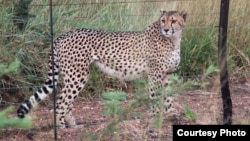In 1900, cheetahs numbered around 100,000. Today, there are just 10,000 in the wild. A new study says being fast is not enough to survive.
Everybody’s knows cheetahs are fast. Some recent studies have clocked them at around 95 kilometers per hour over distances of about 366 meters. So, it seems logical that all that sprinting would zap the cat of a lot of energy and make it vulnerable. The problem is, until recently, no one ever really measured how much energy a cheetah expends.
Dr. John Wilson, who took part in the cheetah research, said the cats can easily deal with those energy outbursts.
“Like any cat, basically, they rest for most of the day. And they have only brief periods of activity," he said. "So, for example, a cheetah would only hunt in the morning for a few hours -- in the afternoon for a few hours. We assume they expend a lot of energy during these chases. They offset those high-energy expenditures by resting for most of the day. So, these blistering speeds that they run for short periods don’t really have an effect on the cheetahs over the entire day.”
If the cheetahs are not winded or weak after the chase, what else might be behind their dwindling numbers? One theory is that other predators – like lions or hyenas – might be stealing most of the cheetahs’ food after they make a kill.
Wilson said, “Our study has found that that’s actually not really the case. Cheetahs lose about 12 percent of the food. So while they lose quite a bit of their food cheetahs are pretty fast eaters. So, they’ve eaten a lot of the food before they lose that food. The act of losing food is that that significant.”
The answer to the cheetah’s vulnerability lies in its physiology. The cat simply burns a lot of calories.
“Because these cheetahs have a fast metabolism – they have huge lungs and a strong heart – their resting metabolic rate is really high," Wilson said. "So, just the act of walking already for a cheetah is pretty expensive. And then the longer they look they look for food the more energy they need to invest in finding the food.”
And therein lies the problem. It’s taking a lot longer for cheetahs to find prey – and they have to walk a lot father to do so.
Humans are to blame. Cheetahs naturally avoid people. But human presence is expanding -- and with it -- the construction of fences that block the hunting routes of cheetahs and other predators. So they have to go a lot farther to either get around the fences or find a place where they can sneak through. That consumes a lot of energy.
Wilson said while this has not affected the number of cheetah cubs being born, it can affect their survival. He gave an example of a female cheetah observed in the desert.
“This mom is under stress already looking for food for herself. Then she needs to look for food for her cub. And if she needs to move further and further, the mother is under more strain and then that puts even more strain on the cub.”
People are also killing the animals that cheetahs hunt. What’s more, cheetahs are illegally captured and sold as pets in the Middle East. However, the conservation group – Born Free USA – said up to 70 percent of the cheetah cubs illegally smuggled through East Africa die.
Earlier this year, Born Free called on members of the CITES treaty – which protects endangered species -- to increase enforcement at borders and improve laws and regulations.
Wilson said there are no simple solutions to help cheetahs cope with human activity, but quick action is needed. He said there’s a 10-percent chance they could become extinct within a 100 years.
The U.S. Fish and Wildlife Service lists cheetahs as an Endangered Species, while the International Union for Conservation of Nature describes the cats as vulnerable. Most of Africa’s cheetahs – about 2,500 – are found in Namibia.











